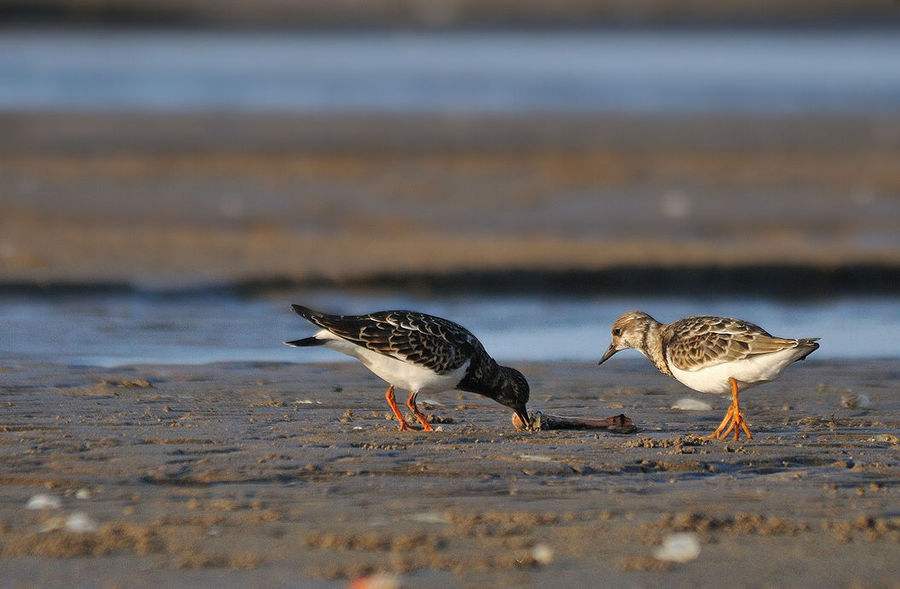Arenaria interpres
IUCN
LCBasic Information
Scientific classification
- name:Arenaria interpres
- Scientific Name:Arenaria interpres,Ruddy Turnstone, Turnstone,Red turncock, brown turncock
- Outline:Wading birds
- Family:Charadriformes Sandpiper
Vital signs
- length:18-24cm
- Weight:82-135g
- lifetime:No textual research information is available
Feature
It got its name from its tendency to turn over rocks to catch small animals hidden within them
Distribution and Habitat
Place of origin: Afghanistan, Albania, Algeria, American Samoa, Angola, Anguilla, Antigua and Barbuda, Argentina, Armenia, Aruba, Australia, Austria, Azerbaijan, Bahamas, Bahrain, Bangladesh, Barbados, Belgium, Belize, Benin, Bermuda, Bolivia, Bonaire, Saint Eustus and Saba Islands, Botswana, Brazil, British Indian Ocean Territory, Brunei Darussalam, Bulgaria, Burkina Faso, Burundi, Cape Verde, Cambodia, Cameroon, Canada, Cayman Islands, Chad, Chile, China, Christmas Island, Cocos (Keeling) Islands, Colombia, Comoros, Congo, Democratic Republic of the Congo, Cook Islands, Costa Rica, Cote d 'Ivoire, Croatia, Cuba, Curacao, Cyprus, Czech Republic, Denmark, Djibouti, Dominica, Dominican Republic, Ecuador, Egypt, El Salvador, Equatorial Guinea, Eritrea, Estonia, Ethiopia, Falkland Islands (Malvinas), Faroe Islands, Fiji, Finland, France, French Guyana Ana, French Polynesia, Gabon, Gambia, Georgia, Germany, Ghana, Gibraltar, Greece, Greenland, Grenada, Guadeloupe, Guam, Guatemala, Gui
Appearance
In summer, the male bird has white head and neck, and fine black longitudinal stripes on the head and pillow. The forehead is white, with a black transverse band stretching between the eyes and passing straight down through the eyes to meet the black jaw. The eyes, ears and larynx are white, the chest and foreneck are black, and the two ends extend to the side of the neck respectively, forming two striped spots; The front end is connected with the black jaw, making the middle of the throat white only. The rest of the lower body is pure white. Back and shoulders orange-red, with black and white spots; The lower back and tail are covered with white feathers, and the waist has a black transverse band; Tail black, outer 5 pairs of tail feathers with narrow white tips; The primary feather is black brown, the feather shaft is white, the inner primary feather base is white; Large overlying feathers are black, with white tip spots, the base of the lateral secondary feathers is also white, the
Details
The foreign name Ruddy Turnstone, no subspecies.

The turnstone snipe is a traveller and winter migrant in China. Spring migrates in April-May and autumn migrates in September-October. Migrations often integrate large, loosely organized groups. Often alone or in small groups. Large groups are also often assembled during migration. The gait is a little shaky when walking, but runs well, flies strongly and straight, and usually does not soar.
It mainly pecks at crustaceans, mollusks, spiders, earthworms, insects and insect larvae. They also eat some grass seeds and berries. Often foraging alone or in small groups. They forage mainly by turning over seagrass and small pebbles on the ground or in shallow water near the water's edge, pecking at crustaceans and other small invertebrates hidden below. They also eat dead animals.
The breeding period is from June to August. It breeds on the Arctic coast. Nests are found on shoals or islands, on sand and under coastal scrub and rocks, and are usually well sheltered. The nest is filled with grass stems, grass leaves and moss. Four eggs are usually laid per litter, but occasionally as few as three and as many as five. The eggs are pear-shaped and pale gray, taupe, or olive green in color. With brown spots. The size of the eggs ranged from 36-44.5×26-31.3 mm, with an average of 40.5×29.3 mm. The male and female incubate the eggs in turn, but the female bird predominates.
The global population is estimated at an average of 460,000 to 730,000 (Wetlands International, 2015). Total population estimates include: 1-10 million migratory birds and 501,000 overwintering birds in China; On average 1,000-10,000 travellers and 50-50,000 overwintering birds in Taiwan, China; South Korea has an average of 50-10,000 travelling birds; Japan has an average of 1,000-10,000 travellers and 501,000 overwintering birds, and 10,000-100,000 breeding pairs; Russia has an average of 1,000-10,000 travelling birds (2009). The European population is estimated at 35,900-77,100 pairs, equivalent to 71,800-154,000 mature individuals (2015).
The overall population trend is declining, although the trend for some populations is unknown (Wetlands International 2015). In North America, this trend is increasing (based on BBS/CBC data: Butcher and Niven 2007), while in Europe, species size is estimated to have declined by less than 25% in 21 years, 9 years (three generations) (BirdLife International 2015).
Listed in the International Union for Conservation of Nature Red List of Threatened Species (IUCN) for 2016 ver 3.1 - Not Threatened (LC).
Listed in China's "National Key Protected Wildlife List" (February 5, 2021) Level 2.
Protect wild animals and eliminate wild meat.
Maintaining ecological balance is everyone's responsibility!








